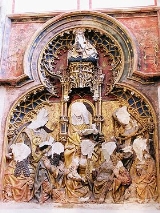
Protestantism and Islam
Encyclopedia
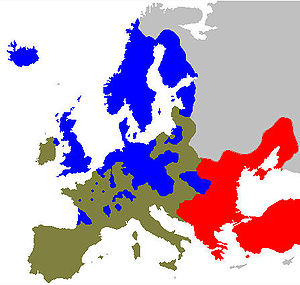
Ottoman Empire
The Ottoman EmpireIt was usually referred to as the "Ottoman Empire", the "Turkish Empire", the "Ottoman Caliphate" or more commonly "Turkey" by its contemporaries...
in southern Europe. As both were in conflict with the Catholic
Catholic
The word catholic comes from the Greek phrase , meaning "on the whole," "according to the whole" or "in general", and is a combination of the Greek words meaning "about" and meaning "whole"...
Holy Roman Empire
Holy Roman Empire
The Holy Roman Empire was a realm that existed from 962 to 1806 in Central Europe.It was ruled by the Holy Roman Emperor. Its character changed during the Middle Ages and the Early Modern period, when the power of the emperor gradually weakened in favour of the princes...
, numerous exchanges occurred, exploring religious similarities and the possibility of trade and military alliances.
Relations became more conflictual in the early modern and modern periods, although recent attempts have been made at rapprochement
Rapprochement
In international relations, a rapprochement, which comes from the French word rapprocher , is a re-establishment of cordial relations, as between two countries...
. In terms of comparative religion, there also interesting similarities, as well as differences, in both religious approaches.
Historical background
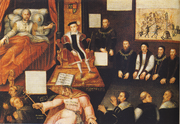
Constantinople
Constantinople was the capital of the Roman, Eastern Roman, Byzantine, Latin, and Ottoman Empires. Throughout most of the Middle Ages, Constantinople was Europe's largest and wealthiest city.-Names:...
in 1453 by Mehmet II and the unification of the Middle East
Middle East
The Middle East is a region that encompasses Western Asia and Northern Africa. It is often used as a synonym for Near East, in opposition to Far East...
under Selim I
Selim I
Selim I, Yavuz Sultân Selim Khan, Hâdim-ül Haramain-ish Sharifain , nicknamed Yavuz "the Stern" or "the Steadfast", but often rendered in English as "the Grim" , was the Sultan of the Ottoman Empire from 1512 to...
, Suleiman the Magnificent
Suleiman the Magnificent
Suleiman I was the tenth and longest-reigning Sultan of the Ottoman Empire, from 1520 to his death in 1566. He is known in the West as Suleiman the Magnificent and in the East, as "The Lawgiver" , for his complete reconstruction of the Ottoman legal system...
, the son of Selim, managed to expand Ottoman rule to Balkans
Balkans
The Balkans is a geopolitical and cultural region of southeastern Europe...
. The Habsburg Empire
Habsburg Monarchy
The Habsburg Monarchy covered the territories ruled by the junior Austrian branch of the House of Habsburg , and then by the successor House of Habsburg-Lorraine , between 1526 and 1867/1918. The Imperial capital was Vienna, except from 1583 to 1611, when it was moved to Prague...
thus entered into direct conflict with the Ottomans.
At the same time the Protestant Reformation
Protestant Reformation
The Protestant Reformation was a 16th-century split within Western Christianity initiated by Martin Luther, John Calvin and other early Protestants. The efforts of the self-described "reformers", who objected to the doctrines, rituals and ecclesiastical structure of the Roman Catholic Church, led...
was taking place in numerous areas of northern and central Europe, in harsh opposition to Papal authority and the Holy Roman Empire
Holy Roman Empire
The Holy Roman Empire was a realm that existed from 962 to 1806 in Central Europe.It was ruled by the Holy Roman Emperor. Its character changed during the Middle Ages and the Early Modern period, when the power of the emperor gradually weakened in favour of the princes...
led by Emperor Charles V
Charles V, Holy Roman Emperor
Charles V was ruler of the Holy Roman Empire from 1519 and, as Charles I, of the Spanish Empire from 1516 until his voluntary retirement and abdication in favor of his younger brother Ferdinand I and his son Philip II in 1556.As...
. This situation led the Protestants to consider various forms of cooperation and rapprochement (religious, commercial, military) with the Muslim world, in opposition to their common Habsburg enemy.
Early religious accommodation (16th-17th century)
During the development of the Reformation, Protestantism and Islam were considered closer to each other than they were to Catholicism: "Islam was seen as closer to Protestantism in banning images from places of worship, in not treating marriage as a sacrament and in rejecting monastic orders".Mutual tolerance
The Sultan of the Ottoman EmpireOttoman Empire
The Ottoman EmpireIt was usually referred to as the "Ottoman Empire", the "Turkish Empire", the "Ottoman Caliphate" or more commonly "Turkey" by its contemporaries...
was known for his tolerance of the Christian
Christian
A Christian is a person who adheres to Christianity, an Abrahamic, monotheistic religion based on the life and teachings of Jesus of Nazareth as recorded in the Canonical gospels and the letters of the New Testament...
and Jewish faiths within his dominions, whereas the King of Spain did not tolerate the Protestant faith. The Ottoman Empire was indeed known at that time for its religious tolerance. Various religious refugees, such as the Huguenots, some Anglicans, Quakers, Anabaptists or even Jesuits or Capuchins
Order of Friars Minor Capuchin
The Order of Friars Minor Capuchin is an Order of friars in the Catholic Church, among the chief offshoots of the Franciscans. The worldwide head of the Order, called the Minister General, is currently Father Mauro Jöhri.-Origins :...
were able to find refuge at Istanbul
Istanbul
Istanbul , historically known as Byzantium and Constantinople , is the largest city of Turkey. Istanbul metropolitan province had 13.26 million people living in it as of December, 2010, which is 18% of Turkey's population and the 3rd largest metropolitan area in Europe after London and...
and in the Ottoman Empire, where they were given right of residence and worship. Further, the Ottomans supported the Calvinists in Transylvania
Transylvania
Transylvania is a historical region in the central part of Romania. Bounded on the east and south by the Carpathian mountain range, historical Transylvania extended in the west to the Apuseni Mountains; however, the term sometimes encompasses not only Transylvania proper, but also the historical...
and Hungary
Hungary
Hungary , officially the Republic of Hungary , is a landlocked country in Central Europe. It is situated in the Carpathian Basin and is bordered by Slovakia to the north, Ukraine and Romania to the east, Serbia and Croatia to the south, Slovenia to the southwest and Austria to the west. The...
but also in France. The contemporary French thinker Jean Bodin
Jean Bodin
Jean Bodin was a French jurist and political philosopher, member of the Parlement of Paris and professor of law in Toulouse. He is best known for his theory of sovereignty; he was also an influential writer on demonology....
wrote:
Martin Luther
Martin Luther
Martin Luther was a German priest, professor of theology and iconic figure of the Protestant Reformation. He strongly disputed the claim that freedom from God's punishment for sin could be purchased with money. He confronted indulgence salesman Johann Tetzel with his Ninety-Five Theses in 1517...
, in his 1528 pamphlet, On War against the Turk
On War against the Turk
On War against the Turk was a book written by Martin Luther in 1528 and published in 1529. It was one of several pamphlets and sermons by Martin Luther about Islam and resistance to the Ottoman Empire, during the critical period of territorial expansion of the Ottoman Empire in Europe, marked by...
, calls for the Germans to resist the Ottoman invasion of Europe, as the catastrophic Siege of Vienna
Siege of Vienna
The Siege of Vienna in 1529 was the first attempt by the Ottoman Empire, led by Suleiman the Magnificent, to capture the city of Vienna, Austria. The siege signalled the pinnacle of the Ottoman Empire's power, the maximum extent of Ottoman expansion in central Europe, and was the result of a...
was lurking, but expressed views of Islam which, compared with his virulent anti-Semitism
Anti-Semitism
Antisemitism is suspicion of, hatred toward, or discrimination against Jews for reasons connected to their Jewish heritage. According to a 2005 U.S...
, are relatively mild. On the one hand, Luther extensively criticized the principles of Islam; on the other hand, he also expressed tolerance for the Islamic faith:
However, this statement mentions "Turks", and it is not clear whether the meaning was of "Turks" as a representation of the specific rule of the Ottoman empire, or as a representation of of Islam in general.
Martin Luther's ambivalence also appears in one of his other comments, in which he said that "A smart Turk makes a better ruler than a dumb Christian".
Efforts at doctrinal rapprochement
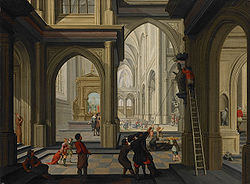
Pope
The Pope is the Bishop of Rome, a position that makes him the leader of the worldwide Catholic Church . In the Catholic Church, the Pope is regarded as the successor of Saint Peter, the Apostle...
, whom he calls an anti-Christ, or the Jews
Jews
The Jews , also known as the Jewish people, are a nation and ethnoreligious group originating in the Israelites or Hebrews of the Ancient Near East. The Jewish ethnicity, nationality, and religion are strongly interrelated, as Judaism is the traditional faith of the Jewish nation...
, whom he describes as "the Devil incarnate". He urges his contemporaries to also see the good aspects in the Turks, and refers to some who were favourable to the Ottoman Empire, and "who actually want the Turk to come and rule, because they think that our German people are wild and uncivilized - indeed that they are half-devil and half-man".
The Ottomans also felt closer to the Protestants than to the Catholics. At one point, a letter was sent from Suleiman the Magnificent
Suleiman the Magnificent
Suleiman I was the tenth and longest-reigning Sultan of the Ottoman Empire, from 1520 to his death in 1566. He is known in the West as Suleiman the Magnificent and in the East, as "The Lawgiver" , for his complete reconstruction of the Ottoman legal system...
to the "Lutherans" in Flanders
Flanders
Flanders is the community of the Flemings but also one of the institutions in Belgium, and a geographical region located in parts of present-day Belgium, France and the Netherlands. "Flanders" can also refer to the northern part of Belgium that contains Brussels, Bruges, Ghent and Antwerp...
, claiming that he felt close to them, "since they did not worship idols, believed in one God and fought against the Pope and Emperor".
This notion of religious similarities was again taken up in epistolary exchanges between Elizabeth I of England
Elizabeth I of England
Elizabeth I was queen regnant of England and Ireland from 17 November 1558 until her death. Sometimes called The Virgin Queen, Gloriana, or Good Queen Bess, Elizabeth was the fifth and last monarch of the Tudor dynasty...
and Sultan Murad III
Murad III
Murad III was the Sultan of the Ottoman Empire from 1574 until his death.-Biography:...
. In one correspondence, Murad entertained the notion that Islam and Protestantism had "much more in common than either did with Roman Catholicism, as both rejected the worship of idols", and argued for an alliance between England and the Ottoman Empire.
In a 1574 letter to the "Members of the Lutheran sect in Flanders and Spain", Murad III
Murad III
Murad III was the Sultan of the Ottoman Empire from 1574 until his death.-Biography:...
made considerable efforts to highlight the similarities between Islamic and Protestants principles. He wrote:
Such claims seem to have been politically inspired as well, with the Ottomans trying to establish religious common ground as a way to secure a political alliance. Elizabeth I herself however made efforts to adjust her own religious rhetoric in order to minimize differences with the Ottomans and facilitate relations. In her correspondence with Murad, she stresses the monotheism and the anti-idolatry of her religion, by uniquely describing herself as:
Military collaboration

Franco-Ottoman alliance
The Franco-Ottoman alliance, also Franco-Turkish alliance, was an alliance established in 1536 between the king of France Francis I and the Turkish ruler of the Ottoman Empire Suleiman the Magnificent. The alliance has been called "the first non-ideological diplomatic alliance of its kind between a...
of 1535. The alliance provided strategic support to, and effectively protected, the kingdom of France from the ambitions of Charles V
Charles V, Holy Roman Emperor
Charles V was ruler of the Holy Roman Empire from 1519 and, as Charles I, of the Spanish Empire from 1516 until his voluntary retirement and abdication in favor of his younger brother Ferdinand I and his son Philip II in 1556.As...
. It also gave the opportunity for the Ottoman Empire to become involved in European diplomacy and gain prestige in its European dominions. Side effects included a lot of negative propaganda against the actions of France and its "unholy" alliance with a Muslim
Muslim
A Muslim, also spelled Moslem, is an adherent of Islam, a monotheistic, Abrahamic religion based on the Quran, which Muslims consider the verbatim word of God as revealed to prophet Muhammad. "Muslim" is the Arabic term for "submitter" .Muslims believe that God is one and incomparable...
power. According to historian Arthur Hassall the consequences of the Franco-Ottoman alliance were far-reaching: "The Ottoman alliance had powerfully contributed to save France from the grasp of Charles V, it had certainly aided Protestantism
Protestantism
Protestantism is one of the three major groupings within Christianity. It is a movement that began in Germany in the early 16th century as a reaction against medieval Roman Catholic doctrines and practices, especially in regards to salvation, justification, and ecclesiology.The doctrines of the...
in Germany
Germany
Germany , officially the Federal Republic of Germany , is a federal parliamentary republic in Europe. The country consists of 16 states while the capital and largest city is Berlin. Germany covers an area of 357,021 km2 and has a largely temperate seasonal climate...
, and from a French point of view, it had rescued the North German allies of Francis I."'
Even after the 1571 Battle of Lepanto
Battle of Lepanto (1571)
The Battle of Lepanto took place on 7 October 1571 when a fleet of the Holy League, a coalition of Catholic maritime states, decisively defeated the main fleet of the Ottoman Empire in five hours of fighting on the northern edge of the Gulf of Patras, off western Greece...
Ottoman support for France would continue however, as well as support for the Dutch
Netherlands
The Netherlands is a constituent country of the Kingdom of the Netherlands, located mainly in North-West Europe and with several islands in the Caribbean. Mainland Netherlands borders the North Sea to the north and west, Belgium to the south, and Germany to the east, and shares maritime borders...
and the English
England
England is a country that is part of the United Kingdom. It shares land borders with Scotland to the north and Wales to the west; the Irish Sea is to the north west, the Celtic Sea to the south west, with the North Sea to the east and the English Channel to the south separating it from continental...
after 1580, and support for Protestants and Calvinists, as a way to counter Habsburg attempts at supremacy in Europe. Various overtures were made by Ottoman rulers to the Protestants, who were also fighting against a common enemy, the Catholic House of Habsburg. Suleiman the Magnificent
Suleiman the Magnificent
Suleiman I was the tenth and longest-reigning Sultan of the Ottoman Empire, from 1520 to his death in 1566. He is known in the West as Suleiman the Magnificent and in the East, as "The Lawgiver" , for his complete reconstruction of the Ottoman legal system...
is known to have sent at least one letter to the "Lutherans" in Flanders
Flanders
Flanders is the community of the Flemings but also one of the institutions in Belgium, and a geographical region located in parts of present-day Belgium, France and the Netherlands. "Flanders" can also refer to the northern part of Belgium that contains Brussels, Bruges, Ghent and Antwerp...
, offering troops at the time they would request, Murad III
Murad III
Murad III was the Sultan of the Ottoman Empire from 1574 until his death.-Biography:...
is also known to have advocated to Elizabeth I an alliance between England and the Ottoman Empire.
Overall, the military activism of the Ottoman Empire
Ottoman Empire
The Ottoman EmpireIt was usually referred to as the "Ottoman Empire", the "Turkish Empire", the "Ottoman Caliphate" or more commonly "Turkey" by its contemporaries...
on the southern European front probably was the reason why Lutheranism
Lutheranism
Lutheranism is a major branch of Western Christianity that identifies with the theology of Martin Luther, a German reformer. Luther's efforts to reform the theology and practice of the church launched the Protestant Reformation...
was able to survive in spite of the opposition of Charles V
Charles V, Holy Roman Emperor
Charles V was ruler of the Holy Roman Empire from 1519 and, as Charles I, of the Spanish Empire from 1516 until his voluntary retirement and abdication in favor of his younger brother Ferdinand I and his son Philip II in 1556.As...
and reach recognition at the Peace of Augsburg
Peace of Augsburg
The Peace of Augsburg, also called the Augsburg Settlement, was a treaty between Charles V and the forces of the Schmalkaldic League, an alliance of Lutheran princes, on September 25, 1555, at the imperial city of Augsburg, now in present-day Bavaria, Germany.It officially ended the religious...
in September 1555: "the consolidation, expansion and legitimization of Lutheranism in Germany by 1555 should be attributed to Ottoman imperialism more than to any other single factor".
The Dutch Revolt and Islam

Portuguese people
The Portuguese are a nation and ethnic group native to the country of Portugal, in the west of the Iberian peninsula of south-west Europe. Their language is Portuguese, and Roman Catholicism is the predominant religion....
, and the Dutch became rather tolerant of the Islamic religion in their colonial possessions after the final subjugation of Macassar
Macassar
-Places:*Makassar, a city in Indonesia**Makassar Strait, a strait in Indonesia*Macassar, Western Cape, a town in South Africa*Macassar Village, Western Cape, an informal settlement in South Africa*Macassar, Mozambique, a village in north-eastern Mozambique...
in 1699.
During the Dutch Revolt, the Dutch were under such a desperate situation that they looked for help from every nationality, and "indeed even a Turk", as wrote the secretary of Jan van Nassau. The Dutch saw Ottoman successes against the Hapsburgs with great interest, and saw Ottoman campaigns in the Mediterranean as an indicator of relief on the Dutch front. William wrote around 1565:
The Dutch looked expectantly at the development of the Siege of Malta (1565)
Siege of Malta (1565)
The Siege of Malta took place in 1565 when the Ottoman Empire invaded the island, then held by the Knights Hospitaller .The Knights, together with between 4-5,000 Maltese men,...
, hoping that the Ottomans "were in Valladolid
Valladolid
Valladolid is a historic city and municipality in north-central Spain, situated at the confluence of the Pisuerga and Esgueva rivers, and located within three wine-making regions: Ribera del Duero, Rueda and Cigales...
already", and used it as a way to obtain concessions from the Spanish crown.

William the Silent
William I, Prince of Orange , also widely known as William the Silent , or simply William of Orange , was the main leader of the Dutch revolt against the Spanish that set off the Eighty Years' War and resulted in the formal independence of the United Provinces in 1648. He was born in the House of...
sent ambassadors to the Ottoman Empire
Ottoman Empire
The Ottoman EmpireIt was usually referred to as the "Ottoman Empire", the "Turkish Empire", the "Ottoman Caliphate" or more commonly "Turkey" by its contemporaries...
for help in 1566. When no other European power would help, "the Dutch cause was offered active support, paradoxically enough, only by the Ottoman Turks". One of the Sultan principal advisers Joseph Miques, Duke of Naxos, delivered a letter to the Calvinists in Antwerp pledging that "the forces of the Ottomans would soon hit Philip II's affairs so hard that he would not even have the time to think of Flanders". The death of Suleiman the Magnificent later in 1566 however, meant that the Ottoman were unable to offer support for several years after. In 1568, William of Orange again sent a request to the Ottomans to attack Spain, without success. The 1566-1568 revolt of the Netherlands finally failed, largely due to the lack of foreign support.
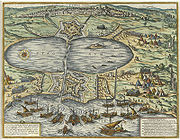
Charles IX of France
Charles IX was King of France, ruling from 1560 until his death. His reign was dominated by the Wars of Religion. He is best known as king at the time of the St. Bartholomew's Day Massacre.-Childhood:...
, through his pro-Huguenot ambassador François de Noailles
François de Noailles
François de Noailles, Papal Prothonotary, made Bishop of Dax in 1556, was French ambassador in Venice in the 1560s, and French ambassador of Charles IX to the Ottoman Empire from 1571 to 1575....
, Bishop of Dax, tried again to obtain the support of the Ottoman ruler Selim II
Selim II
Selim II Sarkhosh Hashoink , also known as "Selim the Sot " or "Selim the Drunkard"; and as "Sarı Selim" or "Selim the Blond", was the Sultan of the Ottoman Empire from 1566 until his death in 1574.-Early years:He was born in Constantinople a son of Suleiman the...
. Selim II sent his support through a messenger, who endeavoured to put the Dutch in contact with the rebellious Moriscos of Spain and the pirates of Algiers. Selim also sent a great fleet which conquered Tunis
Tunis
Tunis is the capital of both the Tunisian Republic and the Tunis Governorate. It is Tunisia's largest city, with a population of 728,453 as of 2004; the greater metropolitan area holds some 2,412,500 inhabitants....
in October 1574 in the Capture of Tunis
Capture of Tunis
The Conquest of Tunis in 1574 marked the final conquest of Tunis by the Ottoman Empire over the Spanish Empire. This was an event of great significance as it decided that North Africa would be under Muslim rather than Christian rule, ended the Spanish Conquista of Northern Africa started under...
, thus succeeding in reducing Spanish pressure on the Dutch, and leading to negotiations at the Conference of Breda. After the death of Charles IX in May 1574 however, contacts weakened, although the Ottomans are said to have supported the 1575-1576 revolt, and establish a Consulate in Antwerp (De Griekse Natie). The Ottomans made a truce with Spain, and shifted their attention to their conflict with Persia, starting the long Ottoman–Safavid War (1578–1590)
Ottoman–Safavid War (1578–1590)
The Ottoman–Safavid War was a war between Safavid Persia under Mohammed Khodabanda and later Abbas I, and the Ottoman Empire under Murad III. It began in 1577-1578 and ended in 1590....
.
The British author William Rainolds (1544–1594) wrote a pamphlet entitled "Calvino-Turcismus" in criticism of these rapprochements.
The phrase Liever Turks dan Paaps
Liever Turks dan Paaps
Liever Turks dan Paaps , also Liever Turksch dan Paus , was a Dutch slogan during the Dutch Revolt of the end of the 16th century...
("Rather a Turk than a Papist"), was a Dutch
Low Countries
The Low Countries are the historical lands around the low-lying delta of the Rhine, Scheldt, and Meuse rivers, including the modern countries of Belgium, the Netherlands, Luxembourg and parts of northern France and western Germany....
slogan during the Dutch Revolt
Dutch Revolt
The Dutch Revolt or the Revolt of the Netherlands This article adopts 1568 as the starting date of the war, as this was the year of the first battles between armies. However, since there is a long period of Protestant vs...
of the end of the 17th century. The slogan was used by the Dutch mercenary naval forces (the "Sea Beggars") in their fight against Catholic Spain. The banner of the Sea Beggars was also similar to that of the Turks, with a crescent on a red background.
The phrase "Liever Turks dan Paaps" was coined as a way to express that life under the Ottoman Sultan would have been more desirable than life under the King of Spain. The Flemish noble D'Esquerdes wrote to this effect that he:
The slogan Liever Turks dan Paaps seems to have been largely rhetorical however, and the Dutch hardly contemplated life under the Sultan at all. Ultimately, the Turks were infidels, and the heresy of Islam alone disqualified them from assuming a more central (or consistent) role in the rebels' program of propaganda.
From 1608, Samuel Pallache
Samuel Pallache
Samuel Pallache was a Jewish-Moroccan merchant, diplomat and pirate who was sent as an envoy to the Dutch Republic in 1608....
served as an intermediary to discuss an alliance between Morocco and the Low Countries. In 1613, the Moroccan Ambassador Al-Hajari discussed in La Hague
La Hague
La Hague is a region on the tip of the Cotentin peninsula in Normandy, France.La Hague is a picturesque place of Precambrian granite cliffs, coves and small fields surrounded by hedges. It faces the Channel Islands and there any many cousins on both side of the Alderney race.The dialect of the...
with the Dutch Prince Maurice of Orange the possibility of an alliance between Holland, the Ottoman Empire
Ottoman Empire
The Ottoman EmpireIt was usually referred to as the "Ottoman Empire", the "Turkish Empire", the "Ottoman Caliphate" or more commonly "Turkey" by its contemporaries...
, Morocco
Morocco
Morocco , officially the Kingdom of Morocco , is a country located in North Africa. It has a population of more than 32 million and an area of 710,850 km², and also primarily administers the disputed region of the Western Sahara...
and the Moriscos, against the common enemy Spain
Spain
Spain , officially the Kingdom of Spain languages]] under the European Charter for Regional or Minority Languages. In each of these, Spain's official name is as follows:;;;;;;), is a country and member state of the European Union located in southwestern Europe on the Iberian Peninsula...
. His book mentions the discussion for a combined offensive on Spain, as well as the religious reasons for the good relations between Islam and Protestantism at the time:
During the Thirty Years War (1618–1648), the Dutch would strengthen contacts with the Moriscos against Spain
Spain
Spain , officially the Kingdom of Spain languages]] under the European Charter for Regional or Minority Languages. In each of these, Spain's official name is as follows:;;;;;;), is a country and member state of the European Union located in southwestern Europe on the Iberian Peninsula...
.
French Huguenots and Islam
French HuguenotHuguenot
The Huguenots were members of the Protestant Reformed Church of France during the 16th and 17th centuries. Since the 17th century, people who formerly would have been called Huguenots have instead simply been called French Protestants, a title suggested by their German co-religionists, the...
s were in contact with the Moriscos in plans against Spain in the 1570s. Around 1575, plans were made for a combined attack of Aragonese Moriscos and Huguenots from Béarn
Béarn
Béarn is one of the traditional provinces of France, located in the Pyrenees mountains and in the plain at their feet, in southwest France. Along with the three Basque provinces of Soule, Lower Navarre, and Labourd, the principality of Bidache, as well as small parts of Gascony, it forms in the...
under Henri de Navarre against Spanish Aragon
Aragon
Aragon is a modern autonomous community in Spain, coextensive with the medieval Kingdom of Aragon. Located in northeastern Spain, the Aragonese autonomous community comprises three provinces : Huesca, Zaragoza, and Teruel. Its capital is Zaragoza...
, in agreement with the king of Algiers
Algiers
' is the capital and largest city of Algeria. According to the 1998 census, the population of the city proper was 1,519,570 and that of the urban agglomeration was 2,135,630. In 2009, the population was about 3,500,000...
and the Ottoman Empire
Ottoman Empire
The Ottoman EmpireIt was usually referred to as the "Ottoman Empire", the "Turkish Empire", the "Ottoman Caliphate" or more commonly "Turkey" by its contemporaries...
, but these projects foundered with the arrival of John of Austria in Aragon and the disarmament of the Moriscos. In 1576, a three-pronged fleet from Constantinople
Constantinople
Constantinople was the capital of the Roman, Eastern Roman, Byzantine, Latin, and Ottoman Empires. Throughout most of the Middle Ages, Constantinople was Europe's largest and wealthiest city.-Names:...
was planned to disembark between Murcia
Murcia
-History:It is widely believed that Murcia's name is derived from the Latin words of Myrtea or Murtea, meaning land of Myrtle , although it may also be a derivation of the word Murtia, which would mean Murtius Village...
and Valencia while the French Huguenots would invade from the north and the Moriscos accomplish their uprising, but the Ottoman fleet failed to arrive.
Alliance between the Barbary states and England
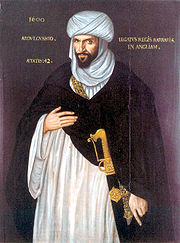
Barbary Company
The Barbary Company or Marocco Company was a trading company established by Queen Elizabeth I of England in 1585 through a patent granted to the Earls of Warwick and Leicester, as well as forty others. When she wrote the patents, Elizabeth emphasized the value of the region's "divers Marchandize.....
, trade developed between England and the Barbary states, and especially Morocco
Morocco
Morocco , officially the Kingdom of Morocco , is a country located in North Africa. It has a population of more than 32 million and an area of 710,850 km², and also primarily administers the disputed region of the Western Sahara...
. Diplomatic relations and an alliance were established between Elizabeth and the Barbary states. England entered in a trading relationship with Morocco detrimental to Spain, selling armour, ammunition, timber, metal in exchange for Moroccan sugar, in spite of a Papal
Pope
The Pope is the Bishop of Rome, a position that makes him the leader of the worldwide Catholic Church . In the Catholic Church, the Pope is regarded as the successor of Saint Peter, the Apostle...
ban, prompting the Papal Nuncio
Nuncio
Nuncio is an ecclesiastical diplomatic title, derived from the ancient Latin word, Nuntius, meaning "envoy." This article addresses this title as well as derived similar titles, all within the structure of the Roman Catholic Church...
in Spain to say of Elizabeth: "there is no evil that is not devised by that woman, who, it is perfectly plain, succoured Mulocco (Abd-el-Malek
Abu Marwan Abd al-Malik I Saadi
Abu Marwan Abd al-Malik I , often simply Abd al-Malik or Mulay Abdelmalek, was the Saadi Sultan of Morocco from 1576 until his death right after the Battle of Ksar El Kebir against Portugal in 1578.-Saadi Prince:...
) with arms, and especially with artillery".
In 1600, Abd el-Ouahed ben Messaoud
Abd el-Ouahed ben Messaoud
Abd el-Ouahed ben Messaoud ben Mohammed Anoun was principal secretary to the Moroccan ruler "Muly Hamet" , and ambassador to the court of Queen Elizabeth I of England in 1600, to promote the establishment of an Anglo-Moroccan alliance....
, the principal secretary to the Moroccan ruler Mulai Ahmad al-Mansur, visited England as an ambassador to the court of Queen Elizabeth I. Abd el-Ouahed ben Messaoud spent 6 months at the court of Elizabeth, in order to negotiate an alliance against Spain
Spain
Spain , officially the Kingdom of Spain languages]] under the European Charter for Regional or Minority Languages. In each of these, Spain's official name is as follows:;;;;;;), is a country and member state of the European Union located in southwestern Europe on the Iberian Peninsula...
. The Moroccan ruler wanted the help of an English fleet to invade Spain, Elizabeth refused, but welcomed the embassy as a sign of insurance, and instead accepted to establish commercial agreements. Queen Elizabeth and king Ahmad continued to discuss various plans for combined military operations, with Elizabeth requesting a payment of 100,000 pounds in advance to king Ahmad for the supply of a fleet, and Ahmad asking for a tall ship to be sent to get the money. Elizabeth "agreed to sell munitions supplies to Morocco, and she and Mulai Ahmad al-Mansur talked on and off about mounting a joint operation against the Spanish". Discussions however remained inconclusive, and both rulers died within two years of the embassy.
Collaboration between the Ottoman Empire and England
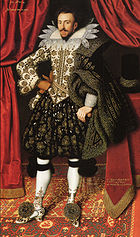
Ottoman Empire
The Ottoman EmpireIt was usually referred to as the "Ottoman Empire", the "Turkish Empire", the "Ottoman Caliphate" or more commonly "Turkey" by its contemporaries...
during the reign of Elizabeth, with the chartering of the Levant Company
Levant Company
The Levant Company, or Turkey Company, was an English chartered company formed in 1581, to regulate English trade with Turkey and the Levant...
and the dispatch of the first English ambassador to the Porte, William Harborne
William Harborne
William Harborne of Great Yarmouth, Norfolk was a diplomat, businessman, and English Ambassador to the Ottoman empire, appointed by Queen Elizabeth I of England.-Establishment of the English Embassy in Constantinople:...
, in 1578. Numerous envoys were dispatched in both directions and epistolary exchanges occurred between Elizabeth and Sultan Murad III
Murad III
Murad III was the Sultan of the Ottoman Empire from 1574 until his death.-Biography:...
. In one correspondence, Murad entertained the notion that Islam and Protestantism had "much more in common than either did with Roman Catholicism, as both rejected the worship of idols", and argued for an alliance between England and the Ottoman Empire. To the dismay of Catholic Europe, England exported tin and lead (for cannon-casting) and ammunition to the Ottoman Empire, and Elizabeth seriously discussed joint military operations with Murad III during the outbreak of war with Spain in 1585, as Francis Walsingham
Francis Walsingham
Sir Francis Walsingham was Principal Secretary to Elizabeth I of England from 1573 until 1590, and is popularly remembered as her "spymaster". Walsingham is frequently cited as one of the earliest practitioners of modern intelligence methods both for espionage and for domestic security...
was lobbying for a direct Ottoman military involvement against the common Spanish enemy.
English writers of the period often expressed admiration towards the "Turks" and the "Ottoman Empire", describing it as endowed with "Majestical and August form and features" and being the "Powerfullest nation in Europe", saying that the Turks were "the only modern people, great in action- he who would behold these times in their greatest glory, could not find a better scene than Turky" and that they had "incredible civility".
Anglo-Turkish piracy
After peace was made with Catholic SpainSpain
Spain , officially the Kingdom of Spain languages]] under the European Charter for Regional or Minority Languages. In each of these, Spain's official name is as follows:;;;;;;), is a country and member state of the European Union located in southwestern Europe on the Iberian Peninsula...
in 1604, English pirates nevertheless continued to raid Christian shipping in the Mediterranean, this time under the protection of the Muslim rulers of the Barbary States, and often converting to Islam
Islam
Islam . The most common are and . : Arabic pronunciation varies regionally. The first vowel ranges from ~~. The second vowel ranges from ~~~...
in the process, in what has been described as Anglo-Turkish piracy
Anglo-Turkish piracy
Anglo-Turkish piracy refers to the collaboration between Barbary pirates and English pirates against Catholic shipping during the 17th century.-Anglo-Turkish collaboration:...
.
Bohemia, Transylvania, Hungary
In Central EuropeCentral Europe
Central Europe or alternatively Middle Europe is a region of the European continent lying between the variously defined areas of Eastern and Western Europe...
, particularly the areas of Bohemia
Bohemia
Bohemia is a historical region in central Europe, occupying the western two-thirds of the traditional Czech Lands. It is located in the contemporary Czech Republic with its capital in Prague...
and Transylvania
Transylvania
Transylvania is a historical region in the central part of Romania. Bounded on the east and south by the Carpathian mountain range, historical Transylvania extended in the west to the Apuseni Mountains; however, the term sometimes encompasses not only Transylvania proper, but also the historical...
, tolerant Ottoman rule meant that the Protestant communities there were protected from Catholic persecutions by the Habsburg. In the 16th century, the Ottomans supported the Calvinists in Transylvania
Transylvania
Transylvania is a historical region in the central part of Romania. Bounded on the east and south by the Carpathian mountain range, historical Transylvania extended in the west to the Apuseni Mountains; however, the term sometimes encompasses not only Transylvania proper, but also the historical...
and Hungary
Hungary
Hungary , officially the Republic of Hungary , is a landlocked country in Central Europe. It is situated in the Carpathian Basin and is bordered by Slovakia to the north, Ukraine and Romania to the east, Serbia and Croatia to the south, Slovenia to the southwest and Austria to the west. The...
and practised religious toleration, giving almost complete freedom, although heavy taxation was imposed. Suleiman the Magnificent in particular supported John Sigismund
John II Sigismund Zápolya
John II Sigismund Zápolya was King of Hungary from 1540 to 1570 and Prince of Transylvania from 1570–1571.-Family:The son of King John I and Isabella Jagiełło, he succeeded his father as an infant...
of Hungary
Hungary
Hungary , officially the Republic of Hungary , is a landlocked country in Central Europe. It is situated in the Carpathian Basin and is bordered by Slovakia to the north, Ukraine and Romania to the east, Serbia and Croatia to the south, Slovenia to the southwest and Austria to the west. The...
, allowing him to establish the Unitarian Church
Unitarianism
Unitarianism is a Christian theological movement, named for its understanding of God as one person, in direct contrast to Trinitarianism which defines God as three persons coexisting consubstantially as one in being....
in Transylvania
Transylvania
Transylvania is a historical region in the central part of Romania. Bounded on the east and south by the Carpathian mountain range, historical Transylvania extended in the west to the Apuseni Mountains; however, the term sometimes encompasses not only Transylvania proper, but also the historical...
. By the end of the century, large parts of the population in Hungary thus became either Lutheran or Calvinist, to become the Reformed Church in Hungary
Reformed Church in Hungary
The Reformed Church in Hungary is a key representative of Christianity in Hungary, being numerically the second-largest denomination in Hungary after the Roman Catholic Church, and the biggest denomination among ethnic Hungarians in Romania...
.

Transylvania
Transylvania is a historical region in the central part of Romania. Bounded on the east and south by the Carpathian mountain range, historical Transylvania extended in the west to the Apuseni Mountains; however, the term sometimes encompasses not only Transylvania proper, but also the historical...
, allied with the Ottoman Turks
Ottoman Turks
The Ottoman Turks were the Turkish-speaking population of the Ottoman Empire who formed the base of the state's military and ruling classes. Reliable information about the early history of Ottoman Turks is scarce, but they take their Turkish name, Osmanlı , from the house of Osman I The Ottoman...
, achieved autonomy for Transylvania, including guaranteeing religious freedom in the rest of Hungary for a short time. In 1620, the Transylvanian Protestant prince Bethlen Gabor, fearful of the Catholic policies of Ferdinand II
Ferdinand II, Holy Roman Emperor
Ferdinand II , a member of the House of Habsburg, was Holy Roman Emperor , King of Bohemia , and King of Hungary . His rule coincided with the Thirty Years' War.- Life :...
, requested a protectorate by Sultan Osman II
Osman II
Sultan Osman II or Othman II was the Sultan of the Ottoman Empire from 1618 until his death on 20 May 1622...
, so that "the Ottoman Empire became the one and only ally of great-power status which the rebellious Bohemian states could muster after they had shaken off Habsburg rule and had elected Frederick V
Frederick V, Elector Palatine
Frederick V was Elector Palatine , and, as Frederick I , King of Bohemia ....
as a Protestant king", Ambassadors were exchanged, with Heinrich Bitter visiting Istanbul in January 1620, and Mehmed Aga visiting Prague in July 1620. The Ottomans offered a force of 60,000 cavalry to Frederick and plans were made for an invasion of Poland with 400,000 troops in exchange for the payment of an annual tribute to the Sultan. The Ottomans defeated the Poles, which were supporting the Habsburg in the Thirty Years' War, at the Battle of Cecora
Battle of Tutora (1620)
The Battle of Ţuţora was a battle between the Polish-Lithuanian Commonwealth and Ottoman forces , fought from 17 September to 7 October 1620 in Moldavia, near the Prut River.- Prelude :Because of the failure of Commonwealth diplomatic mission to Constantinople, and violations of the Treaty of...
in September-October 1620, but were not able to further intervene efficiently before the Bohemian defeat at the Battle of the White Mountain in November 1620.
At the end of the century, the Hungarian leader Imre Thököly
Imre Thököly
Count Imre Thököly de Késmárk was a Hungarian statesman, leader of an anti-Habsburg uprising, Prince of Transylvania, and vassal king of Upper Hungary.- Early life :Imre Thököly was born at Késmárk, Royal Hungary Count Imre Thököly de Késmárk (Thököly/Tököly/Tökölli Imre in Hungarian, Mirko...
, in resistance to the anti-Protestant policies of the Habsburg, asked and obtained, the military help of the Ottoman Grand Vizier Kara Mustafa
Kara Mustafa
Merzifonlu Kara Mustafa Pasha was an Ottoman military leader and grand vizier who was a central character in the empire's last attempts at expansion into both Central Europe and Eastern Europe.-His Name:...
, leading to the 1683 Ottoman attack on the Habsburg Empire and the Battle of Vienna
Battle of Vienna
The Battle of Vienna took place on 11 and 12 September 1683 after Vienna had been besieged by the Ottoman Empire for two months...
.
In the 16th century Hungary had become almost entirely Protestant, with first Lutheranism
Lutheranism
Lutheranism is a major branch of Western Christianity that identifies with the theology of Martin Luther, a German reformer. Luther's efforts to reform the theology and practice of the church launched the Protestant Reformation...
, then soon afterwards Calvinism
Calvinism
Calvinism is a Protestant theological system and an approach to the Christian life...
, but following the Habsburg policy of Counter-Reformation
Counter-Reformation
The Counter-Reformation was the period of Catholic revival beginning with the Council of Trent and ending at the close of the Thirty Years' War, 1648 as a response to the Protestant Reformation.The Counter-Reformation was a comprehensive effort, composed of four major elements:#Ecclesiastical or...
the western part of the country finally returned to Catholicism, while the eastern part has managed to this day to remain strongly Protestant: "although the Habsburg succeeded in re-Catholicising Royal Hungary, east of the Tisza
Tisza
The Tisza or Tisa is one of the main rivers of Central Europe. It rises in Ukraine, and is formed near Rakhiv by the junction of headwaters White Tisa, whose source is in the Chornohora mountains and Black Tisa, which springs in the Gorgany range...
the Reformation remained almost intact in the spirit of peaceful coexistence between the three recognized nations and respect for their diverse creeds".
Relations with Persia
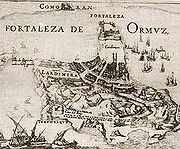
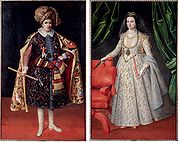
East India Company
The East India Company was an early English joint-stock company that was formed initially for pursuing trade with the East Indies, but that ended up trading mainly with the Indian subcontinent and China...
and in 1622 "a joint Anglo-Persian force expelled the Portuguese and Spanish traders from the Persian Gulf
Persian Gulf
The Persian Gulf, in Southwest Asia, is an extension of the Indian Ocean located between Iran and the Arabian Peninsula.The Persian Gulf was the focus of the 1980–1988 Iran-Iraq War, in which each side attacked the other's oil tankers...
" in the Capture of Ormuz
Capture of Ormuz (1622)
In the 1622 Capture of Ormuz, a Anglo-Persian force combined to take over the Portuguese garrison at Hormuz Island, thus opening up Persian trade with England...
.
A group of English adventurers, led by Robert Shirley
Robert Shirley
Sir Robert Shirley was an English traveler and adventurer, younger brother of Sir Anthony Shirley and of the adventurer Sir Thomas.-Diplomatic Activities:Robert went with his brother Anthony to Persia in 1598...
had a key role in modernizing the Persian army and developing its contacts with the West. In 1624, Robert Shirley led an embassy to England
England
England is a country that is part of the United Kingdom. It shares land borders with Scotland to the north and Wales to the west; the Irish Sea is to the north west, the Celtic Sea to the south west, with the North Sea to the east and the English Channel to the south separating it from continental...
in order to obtain trade agreements.
Later relations
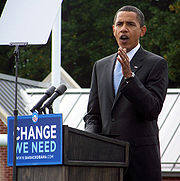
Ottoman Empire
The Ottoman EmpireIt was usually referred to as the "Ottoman Empire", the "Turkish Empire", the "Ottoman Caliphate" or more commonly "Turkey" by its contemporaries...
waned from its 16th century peak, making attempts at alliance and conciliation less relevant.
Eventually, relations between Protestantism and Islam have often tended to become conflicted. In the context of the United States
United States
The United States of America is a federal constitutional republic comprising fifty states and a federal district...
, Protestant missionaries seem to have been active in portraying Islam in an unfavourable light, representing it as "the epitome of antichristian darkness and political tyranny", in a way that helped construct in opposition an American national identity as "modern, democratic and Christian". Some famous Protestants have criticized Islam like Pat Robertson
Pat Robertson
Marion Gordon "Pat" Robertson is a media mogul, television evangelist, ex-Baptist minister and businessman who is politically aligned with the Christian Right in the United States....
Jerry Falwell
Jerry Falwell
Jerry Lamon Falwell, Sr. was an evangelical fundamentalist Southern Baptist pastor, televangelist, and a conservative commentator from the United States. He was the founding pastor of the Thomas Road Baptist Church, a megachurch in Lynchburg, Virginia...
, Jerry Vines
Jerry Vines
Charles Jerry Vines is an American preacher and former pastor of the then nation's third largest Southern Baptist church, the First Baptist Church of Jacksonville, Florida. Like his former co-pastor Homer G...
, R. Albert Mohler, Jr.
R. Albert Mohler, Jr.
Mohler's approach to Muslims is driven by his belief in the relevance of the Christian Gospel to all people.-Media appearances:Mohler appeared on MSNBC's Donahue on August 20, 2002. The subject was Christian evangelization of Jews...
and Franklin Graham
Franklin Graham
William Franklin Graham III , known publicly as Franklin Graham, is an American Christian evangelist and missionary. He is the president and CEO of both the Billy Graham Evangelistic Association and the international Christian relief organization Samaritan's Purse.He currently lives in Boone,...
. The Jyllands-Posten Muhammad cartoons controversy
Jyllands-Posten Muhammad cartoons controversy
The Jyllands-Posten Muhammad cartoons controversy began after 12 editorial cartoons, most of which depicted the Islamic prophet Muhammad, were published in the Danish newspaper Jyllands-Posten on 30 September 2005...
happened in Denmark
Denmark
Denmark is a Scandinavian country in Northern Europe. The countries of Denmark and Greenland, as well as the Faroe Islands, constitute the Kingdom of Denmark . It is the southernmost of the Nordic countries, southwest of Sweden and south of Norway, and bordered to the south by Germany. Denmark...
, a mostly Protestant country.
Modern history
In modern history, recent conflicts such as the Persian Gulf WarGulf War
The Persian Gulf War , commonly referred to as simply the Gulf War, was a war waged by a U.N.-authorized coalition force from 34 nations led by the United States, against Iraq in response to Iraq's invasion and annexation of Kuwait.The war is also known under other names, such as the First Gulf...
and the Iraq War have encouraged perceptions of unavoidable civilization conflicts between Islam and the rest of the world, giving rise to the theory of The Clash of Civilizations, as opposed to the Dialogue Among Civilizations
Dialogue Among Civilizations
Former Iranian president Mohammad Khatami introduced the idea of Dialogue Among Civilizations as a response to Samuel P. Huntington’s theory of a Clash of Civilizations.-Introduction:...
. In 2009 however, the new United States President Barack Obama
Barack Obama
Barack Hussein Obama II is the 44th and current President of the United States. He is the first African American to hold the office. Obama previously served as a United States Senator from Illinois, from January 2005 until he resigned following his victory in the 2008 presidential election.Born in...
attempted to defuse this long period of conflict by stating:
Comparative elements
Besides the obvious differences between the two religious, there are also many similarities in their outlooks and attitudes to faith, especially in respect to textual criticism, iconoclasm, tendencies to fundamentalism, rejection of marriage as a sacrament, or the rejection of monastic orders.Textual criticism
Islam and Protestantism have in common a reliance on textual criticism of the Book. In a sense, Islam thus has a claim to being the first "Reformation", long before Christian reformation in the 17th century. This historical precedence combines to fact that Islam incorporates to a certain extent the Jewish and Christian traditions, recognizing the same God and defining JesusJesus
Jesus of Nazareth , commonly referred to as Jesus Christ or simply as Jesus or Christ, is the central figure of Christianity...
as a prophet, as well as recognizing Hebrew prophets, thus having a claim to encompassing all the religions of the Book.
Iconoclasm
Obviously, the rejection of images, although more strongly rejected in the case of Islam, is a common point in Protestantism and Islam. This was already extensively recognized from the earliest times, as in the correspondence between Elizabeth I of England and her Ottoman EmpireOttoman Empire
The Ottoman EmpireIt was usually referred to as the "Ottoman Empire", the "Turkish Empire", the "Ottoman Caliphate" or more commonly "Turkey" by its contemporaries...
counterparts, in which she implied that Protestantism was closer to Islam than to Catholicism. This is also a point developed by Martin Luther
Martin Luther
Martin Luther was a German priest, professor of theology and iconic figure of the Protestant Reformation. He strongly disputed the claim that freedom from God's punishment for sin could be purchased with money. He confronted indulgence salesman Johann Tetzel with his Ninety-Five Theses in 1517...
in On War against the Turk
On War against the Turk
On War against the Turk was a book written by Martin Luther in 1528 and published in 1529. It was one of several pamphlets and sermons by Martin Luther about Islam and resistance to the Ottoman Empire, during the critical period of territorial expansion of the Ottoman Empire in Europe, marked by...
, in which he praised the Ottomans
Ottoman Empire
The Ottoman EmpireIt was usually referred to as the "Ottoman Empire", the "Turkish Empire", the "Ottoman Caliphate" or more commonly "Turkey" by its contemporaries...
for their rigorous iconoclasm:
Fundamentalism
Islam and Protestantism have in common that they are both based on a direct analysis of the scriptures (the BibleBible
The Bible refers to any one of the collections of the primary religious texts of Judaism and Christianity. There is no common version of the Bible, as the individual books , their contents and their order vary among denominations...
for Protestantism and the Koran for Islam). This can be contrasted to Catholicism in which knowledge is analysed, formalized and distributed by the existing structure of the Church. Islam and Protestantism are thus both based on "a rhetorical commitment to a universal mission", when Catholicism is based on an international structure. This leads to possibilities of fundamentalism
Fundamentalism
Fundamentalism is strict adherence to specific theological doctrines usually understood as a reaction against Modernist theology. The term "fundamentalism" was originally coined by its supporters to describe a specific package of theological beliefs that developed into a movement within the...
, based on the popular reinterpretation of scriptures by radical elements. The term "fundamentalism" was first used in America in the 1920, to describe "the consciously anti-modernist wing of Protestantism".
Islamic and Protestant fundamentalism also tend to be very normative of individual's behaviours: "Religious fundamentalism in Protestantism and Islam is very concerned with norms surrounding gender, sexuality, and family", although Protestant fundamentalism tends to focus on individual behaviour, whereas Islamic fundamentalism tends to develop laws for the community.
Islamic Protestantism
Parallels have regularly been drawn in the similar attitudes of Islam and Protestantism towards the Scriptures. Some trends in Muslim revival have thus been defined as "Islamic ProtestantismIslamic Protestantism
Islamic Protestantism has been used to describe movements advocating for reformation in Islam, on a parallel to the Protestant Reformation.Parallels between Islam and Protestantism have long been made...
". In a sense "Islamization is a political movement to combat Westernization using the methods of Western culture, namely a form of Protestantism within Islam itself".
Vitality
Islam and Protestantism shared a common vitality in the modern world: "The two most dynamic religious movements in the contemporary world are what can loosely be called popular Protestantism and resurgent Islam", although their approach to civil society is different.See also
- Islam in EnglandIslam in EnglandIslam in England is the largest non-Christian religion, with most Muslims being immigrants from South Asia or descendants of immigrants from that region...
- Mormonism and IslamMormonism and IslamMormonism and Islam have been compared to one another ever since the earliest origins of the former in the nineteenth century, often by detractors of one religion or the other—or both. For instance, Joseph Smith, Jr., the founding prophet of Mormonism, was referred to as "the modern Mahomet" by...
- Islam and other religionsIslam and other religionsOver the centuries of Islamic history, Muslim rulers, Islamic scholars, and ordinary Muslims have held many different attitudes towards other religions...
- Divisions of the world in Islam
External links
- Wittenburg and Mecca issue of Logia: A Journal of Lutheran Theology

